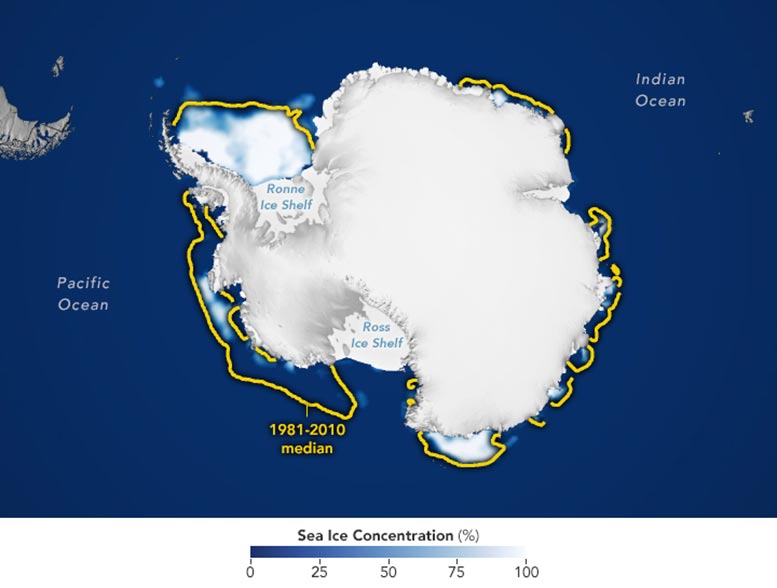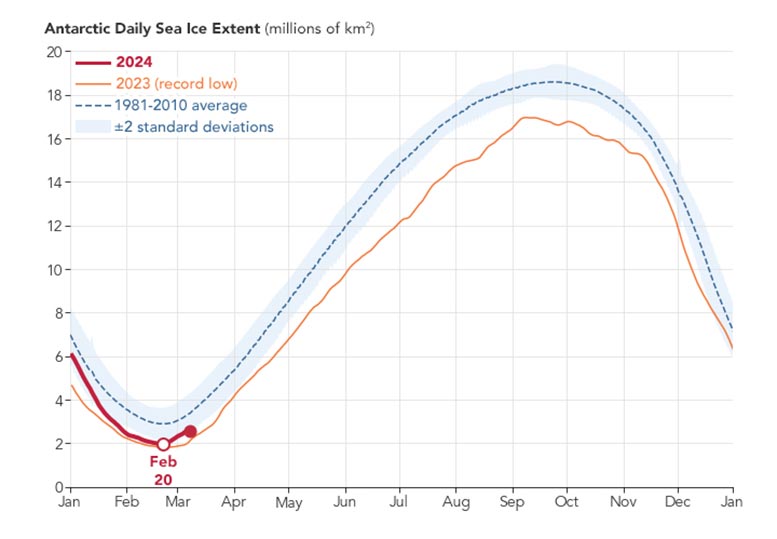
On February 20, 2024, Antarctica reached its seasonal minimum ice extent, hitting near-historic lows for the third consecutive year. This continues a worrying trend that may indicate a long-term climatic shift, with significant environmental implications.
Sea ice coverage reached its seasonal minimum in February 2024, tying with 2022 for the second-lowest extent in the satellite record.
In the waters around Antarctica, ice coverage in 2024 shrank to near-historic lows for the third year in a row. The recurring loss hints at a long-term shift in conditions in the Southern Ocean, scientists say.
Antarctic sea ice reached its lowest annual extent on February 20, 2024, with a total of 1.99 million square kilometers (768,000 square miles). That’s 30 percent below the 1981 to 2010 end-of-summer average—a difference in ice cover that spans an area about the size of Texas.
Scientists with NASA and the National Snow and Ice Data Center (NSIDC) at the University of Colorado, Boulder, track these seasonal and annual fluctuations because sea ice shapes Earth’s polar ecosystems and plays a significant role in global climate.
The map above shows the ice extent on February 20, the day of the annual minimum extent. To determine extent, scientists project satellite observations of sea ice onto a grid and then add up the total area of each cell that is at least 15 percent ice-covered. The yellow outline shows the median sea ice extent for February from 1981 to 2010. A median is the middle value; that is, half of the extents were larger than the yellow line and half were smaller.
The analysis is based on data collected by microwave sensors aboard the Nimbus-7 satellite, jointly operated by NASA and the National Oceanic and Atmospheric Administration (NOAA), along with satellites in the Defense Meteorological Satellite Program.
This chart shows the daily sea ice extent through early March 2024 (red) compared to the 2023 record low (orange) and the average extent from 1981 to 2010 (blue). The recent minimum tied with February 2022 for the second-lowest ice coverage around Antarctica and was close to the 2023 all-time low of 1.79 million square kilometers (691,000 square miles). With the latest ice retreat, this year marked the lowest three-year average for ice coverage ever observed around the Antarctic continent.
Historically, the area of sea ice surrounding the Antarctic continent has fluctuated dramatically from year to year, but averages over decades have been relatively stable. In recent years, though, sea ice cover around Antarctica has plummeted.
Animation of Antarctic sea ice maximum extent, September 10, 2023, to its minimum, February 20, 2024. Credit: NASA’s Scientific Visualization Studio
“In 2016, we saw what some people are calling a regime shift,” said sea ice scientist Walt Meier of the NSIDC. “The Antarctic sea ice coverage dropped and has largely remained lower than normal. Over the last seven years, we’ve had three record lows.”
It’s too soon to know whether recent sea ice lows at the South Pole point to a long-term change rather than a statistical fluctuation, but Meier believes long-term declines are inevitable. “It’s only a matter of time,” Meier said. “After six, seven, eight years, it’s starting to look like maybe it’s happening. It’s just a question of whether there’s enough data to say for sure.”
NASA Earth Observatory images by Lauren Dauphin, using data from the National Snow and Ice Data Center. Story by James Riordon/NASA’s Earth Science News Team, adapted for Earth Observatory.










“…, hitting near-historic lows for the third consecutive year.”
Let us know when it actually breaks the record for three consecutive years.